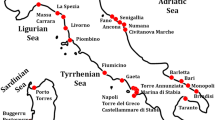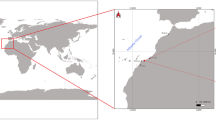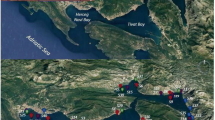Abstract
In this study we propose, a multi-step strategy of selection and characterization of long-term dataset of contaminant concentrations in different environmental matrices (i.e., water and sediment). Starting from a high quality and homogeneous dataset of chemical parameters, a selection of a usable refined dataset followed by statistical characterization and hazard assessment was performed. The database of chemical contamination data from monitoring activities in the coastal marine water area of the Campania Region (Italy) produced by the Regional Agency for Environmental Protection of Campania (ARPAC) between 2013 and 2019 was utilized. Descriptive and multivariate statistics were applied to the extracted data subset to describe spatial variability and to investigate the relationships between matrices and contaminants. In addition, the impact on the sediment matrix was considered using the contamination factor (Cf), the sediment quality guidelines (SQG), and the probability of exceedance (PoE) of given thresholds for metals and organic compounds. The results highlighted the main anthropogenic pressures between the Gulf of Pozzuoli and the Gulf of Napoli, and the potential hazard posed in particular by metals (i.e., Pb, C, and Hg), TBT, and PAHs. A wide range of As concentration along the Campania coastline and Ni occurrence in the southern part of the region, mainly attributable to geogenic origin, was also evidenced. This approach allows extracting new knowledge from large dataset systematically collected by ARPAC monitoring activity, to support possible actions of contamination control and mitigation.








Similar content being viewed by others
Data availability
The data analyzed during this study are available on institutional sites of ARPAC (https://dati.arpacampania.it/group/marino-costiero) and ISPRA (http://www.db-strategiamarina.isprambiente.it/app/#/).
References
Albanese S, Iavazzo P, Adamo P, Lima A, De Vivo B (2013) Assessment of the environmental conditions of the Sarno river basin (south Italy): a stream sediment approach. Environ Geochem Health 35:283–297
Armiento G, Caprioli R, Cerbone A, Chiavarini S, Crovato C, De Cassan M, De Rosa L, Montereali MR, Nardi E, Nardi L, Pezza M, Proposito M, Rimauro J, Salerno A, Salluzzo A, Spaziani F, Zaza F (2020) Current status of coastal sediments contamination in the former industrial area of Bagnoli-Coroglio (Naples, Italy). Chem Ecol 36(6):579–597. https://doi.org/10.1080/02757540.2020.1747448
Balassone G, Aiello G, Barra D, Cappelletti P, De Bonis A, Donadio C, Guida M, Melluso L, Morra V, Parisi R, Pennetta M, Siciliano A (2016) Effects of anthropogenic activities in a Mediterranean coastland: the case study of the Falerno-Domitio littoral in Campania, Tyrrhenian Sea (southern Italy). Mar Pollut Bull 112:271–290
Bierman P, Lewis M, Ostendorf B, Tanner J (2011) A review of methods for analysing spatial and temporal patterns in coastal water quality. Ecol Ind 11:103–114
Birch G, Taylor S (1999) Source of heavy metals in sediments of the Port Jackson estuary, Australia. Sci Total Environ 227:123–138
Boye K, Lindström B, Boström G, Kreuger J (2019) Long-term data from the Swedish National Environmental Monitoring Program of Pesticides in Surface Waters. J Environ Qual 48:1109–1119
Budetta P, Santo A, Vivenzio F (2008) Landslide hazard mapping along the coastline of the Cilento region (Italy) by means of a GIS-based parameter rating approach. Geomorphology 94(3–4):340–352. https://doi.org/10.1016/j.geomorph.2006.10.034
Cicchella D, Giaccio L, Lima A, Albanese S, Cosenza A, Civitillo D, De Vivo B (2014) Assessment of the topsoil heavy metals pollution in the Sarno River basin, south Italy. Environ Earth Sci 71(12):5129–5143. https://doi.org/10.1007/s12665-013-2916-8
De Pippo T, Donadio C, Pennetta M, Petrosino C, Terlizzi F, Valente A (2008) Coastal hazard assessment and mapping in Northern Campania, Italy. Geomorphology 97:451–466
Ferraro L, Sprovieri M, Alberico I, Lirer F, Prevedello L, Marsella E (2006) Benthic foraminifera and heavy metals distribution: a case study from the Naples Harbour (Tyrrhenian Sea, Southern Italy). Environ Pollut 142(2):274–287. https://doi.org/10.1016/j.envpol.2005.10.026
Guida D, Valente A (2019) Terrestrial and marine landforms along the Cilento Coastland (Southern Italy): a framework for landslide hazard assessment and environmental conservation. Water 11:2618. https://doi.org/10.3390/w11122618
Hakanson L (1980) An ecological risk index for aquatic pollution control A Sedimentological Approach. Water Res 14(8):975–1001. https://doi.org/10.1016/0043-1354(80)90143-8
Helsel DR (2006) Fabricating data: How substituting values for nondetects can ruin results, and what can be done about it. Chemosphere 65:2434–2439
Jahan S, Strezov V (2018) Comparison of pollution indices for the assessment of heavy metals in the sediments of seaports of NSW, Australia. Mar Pollut Bull 128:295–306
Lofrano G, Libralato G, Alfieri A, Carotenuto M (2016) Metals and tributyltin sediment contamination along the Southeastern Tyrrhenian Sea coast. Chemosphere 144:399–407
Long ER, MacDonald DD (1998) Recommended uses of empirically derived, sediment quality guidelines for marine and estuarine ecosystems. Hum Ecol Risk Assess 4(5):1019–1039. https://doi.org/10.1080/10807039891284956
Long ER, Macdonald DD, Smith SL et al (1995) Incidence of adverse biological effects within ranges of chemical concentrations in marine and estuarine sediments. Environ Manage 19:81–97. https://doi.org/10.1007/BF02472006
Macdonald DD, Carr RS, Calder FD et al (1996) Development and evaluation of sediment quality guidelines for Florida coastal waters. Ecotoxicology 5:253–278. https://doi.org/10.1007/BF00118995
Minolfi G, Albanese S, Lima A, Tarvainen T, Fortelli A, De Vivo B (2018) A regional approach to the environmental risk assessment-Human health risk assessment case study in the Campania region. J Geochem Explor 184:400–416. https://doi.org/10.1016/j.gexplo.2016.12.010
Solomon KR, Baker DB, Richards RP, Dixon KR, Klaine SJ, La Point TW, ..., Williams WM (1996) Ecological risk assessment of atrazine in North American surface waters. Environ Toxicol Chem Int J 15(1), 31-76.https://doi.org/10.1002/etc.5620150105
Sprovieri M, Sammartino S, Salvagio Manta D, Marsella E, Ferraro L (2006) Heavy metals in top core sediments from the southern Campania shelf (Italy): Hints to define large-scale geochemical backgrounds. Chem Ecol 22(1):65–91
TavakolySany SB, Hashim R, Rezayi M, Salleh A, Safari O (2014) A review of strategies to monitor water and sediment quality for a sustainability assessment of marine environment. Environ Sci Pollut Res 21:813–833. https://doi.org/10.1007/s11356-013-2217-5
Thiombane M, Martín-Fernández JA, Albanese S, Lima A, Doherty A, De Vivo B (2018) Exploratory analysis of multi-element geochemical patterns in soil from the Sarno RiverBasin (Campania region, southern Italy) through Compositional Data Analysis (CODA). https://doi.org/10.1016/j.gexplo.2018.03.010
Tornero V, d’Alcalà MR (2014) Contamination by hazardous substances in the Gulf of Naples and nearby coastal areas: a review of sources, environmental levels and potential impacts in the MSFD perspective. Sci Total Environ 466:820–840. https://doi.org/10.1016/j.scitotenv.2013.06.106
Tueros I, Borja A, Larreta J, Rodríguez JG, Valencia V, Millán E (2009) Integrating long-term water and sediment pollution data, in assessing chemical status within the European Water Framework Directive. Mar Pollut Bull 58:1389–1400
Turekian KK, Wedepohl KH (1961) Distribution of the elements in some major units of the earth’s crust. Geol Soc Am Bull 72(2):175–192. https://doi.org/10.1130/0016-7606(1961)72[175:DOTEIS]2.0.CO;2
Zhou F, Liu Y, Guo H (2007) Application of multivariate statistical methods to water quality assessment of the watercourses in Northwestern New Territories, Hong Kong. Environ Monit Assess 132:1–13
Funding
In this study ENEA was supported through the PO FEAMP (Fondo Europeo per gli Affari Marittimi e la Pesca) Campania 2014–2020 under the project “Innovazione, sviluppo e sostenibilità nel settore della pesca e dell’acquacoltura per la Regione Campania—Misura 2.51.”
Author information
Authors and Affiliations
Contributions
Conceptualization and methodology were performed by Sonia Manzo and Luisa Parrella. Data collection was performed by Simona Schiavo, Stefano Capone, and Anna Valeria Siciliano. Visualization was done by Carlo Tebano. Formal analysis was performed by Luisa Parrella, Fabio Spaziani, and Salvatore Chiavarini. The first draft of the manuscript was written by Sonia Manzo. Lucio De Maio and Giovanna Armiento revised previous versions of the manuscript. All authors read and approved the final manuscript.
Corresponding author
Ethics declarations
Ethical approval and consent to participate.
Not applicable.
Consent to publish
Not applicable.
Conflict of interest
The authors declare no competing interests.
Additional information
Responsible Editor: V.V.S.S. Sarma
Publisher's note
Springer Nature remains neutral with regard to jurisdictional claims in published maps and institutional affiliations.
Rights and permissions
About this article
Cite this article
Manzo, S., Parrella, L., Schiavo, S. et al. Gathering new knowledge from existing monitoring dataset of Campania marine coastal area (Southern Italy). Environ Sci Pollut Res 29, 83291–83303 (2022). https://doi.org/10.1007/s11356-022-21615-x
Received:
Accepted:
Published:
Issue Date:
DOI: https://doi.org/10.1007/s11356-022-21615-x




